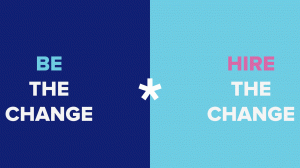Inclusive & Empowering Leadership is a key pillar in shaping workplace cultures that help people and businesses thrive. Shifting leadership models by prioritizing more human-centric values and practices at work helps companies attract, engage and retain people. Inclusive leaders make it their mission to enhance employee experience through people empowerment and creating workplace cultures that prioritizes diversity and inclusion. Want to learn more about building a culture of employee retention through inclusive & empowering leadership? Then this article is for you. Let’s dive in.
Inclusive & Empowering Leadership is a key pillar in shaping workplace cultures that help people and businesses thrive.
Firstly, what is inclusive & empowering leadership?
Leadership is workplace culture in action and the primary enabling factor for quality experiences and thriving cultures at work. While cultural changes are often pushed from the bottom-up, key transformations are enabled through changes at the leadership level.
Traditional organizational structures (rooted in capitalist logic) set a top-down leadership style as the default.
This involves elitist decision making that isn’t open to the opinions and expertise of other people across the organizations, and is resistant to address their needs..
Inclusive and empowering leadership challenges this model by prioritizing collaborative and human-centric approaches (which are strategic in leveraging diversity, equity and inclusion goals) and help create an environment that fosters equal opportunities, respect, belonging and celebration of individuals’ uniqueness.
From the skill set point of view, Inclusive & Empowering Leadership is a leadership style that values potential, mentorship and learning.
This leadership culture provides spaces for exploration and risks, growth mindset, human experiences, and diverse sets of skills.
Disempowering workplace cultures are the number one reason why people quit their job.
Involving leaders and executives in developing their own inclusive leadership skills is a key aspect of creating a thriving workplace culture. It means activating a shift at the core of a company's decision-making and accelerating that transformation across the whole organization.
In fact, Inclusive & empowering leadership is key when it comes to building a culture of retention.
When people have a negative experience of work, such as they aren’t allowed to be their authentic selves, they aren’t seen or valued, or they often have to compromise their needs, ultimately they end up leaving.
In today’s world of work, no company can afford not to invest in inclusive & empowering leadership development.
If the leadership team isn't actively implementing community building strategies for a workplace culture that fosters diversity and inclusion, or expanding leadership skills that foster an empowering employee experience, then their company will see many undesirable negative effects.
This can manifest as;
- Talent retention issues with increased turnover costs, leading to companies wasting time and money.
- Flat team morale with dissatisfaction and unhappiness spreading throughout the organization. This can lead to a low performing workforce, people even getting sick more often and a domino effect of frustration at work.
- Loss of competitive value in the workforce market, as companies don’t meet modern workforce needs. Ultimately this pushes valuable employees away and sends them towards workplaces or employment models that treat inclusive & empowering leadership as a priority.
Companies and leaders can start to change the cultural compass towards inclusive & empowering leadership by shifting the way they understand leadership. They need to recognize the importance of investing in empowering leadership for their people and business success.
Being conscious of context means knowing that the personal, professional and political are all connected, and that they influence our business-building process.
Leadership is also about being aware of the social and cultural impact of our business, exploring possibilities to make a positive impact and promoting empowering practices at work. The role of a business owner comes with social and cultural responsibilities and it’s essential to conduct business in a human-centric way.
Let’s look at what inclusion & empowering leadership looks like in action with some examples:
- The leader acts as a mentor, collaborates with the team members and supports their growth.
- The leader provides equal opportunities for career development and learning to the team members.
- The leader celebrates wins and shows gratitude to their team members.
- The leader leads by example and practices sustainable routines at work, so team members can follow along.
There are more additions to this list in our Business of thriving e-book: FairForce’s Guide To Building A Workplace Culture That Makes People Stay. And Businesses Win. Learn more here.
How many of these can you spot in your workplace? It might be that you’re closer than you realized to this kind of inclusive & empowering leadership. Or maybe you’ve identified gaps and areas for improvement. Either way, there are immense benefits to ongoing investment in and commitment to inclusive & empowering leadership.
Some of the many benefits of inclusive & empowering leadership are:
- People learn by experience. By putting the theory into practice in your leadership you’re helping people to have a felt sense of what it means to be led in a compassionate and empowering way. This has a ripple out effect far beyond work. By demonstrating this type of leadership at work, you’re modeling it to your employees so they can explore it in their own lives and projects outside of work too.
- One of the main objectives of inclusive & empowering leadership is to make people feel safer at work, more comfortable to be their authentic selves and more valued. This leads to professional growth, employees having access to more creativity and being more engaged.
- With inclusive & empowering leadership, people tend to feel more connected to the company’s mission which improves collaborative systems, makes feedback easier and improves overall performance.
Hopefully this article has helped you to understand your own workplace culture and leadership model. Companies that invest in developing their people personally and professionally, with inclusive & empowering leadership, are set to enhance retention and thriving cultures. Make sure you’re one of them.
At FairForce, we focus on researching trends, designing best practices, and delivering holistic solutions to building and shaping culture and experience for workplaces that care about leading the change.
If you are ready to build thriving workplace cultures and need a trusted partner to support you in walking this path, schedule a FREE STRATEGY CALL to talk to our culture team.










